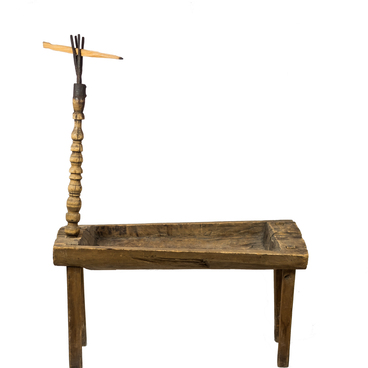This pot got its name (dyrovatka) after the round hole (in Russian, dyra) near its bottom. It was covered with a wooden stick when preparing food or drinks. Such pots were used to make kvass (a soft, bread-based beverage), beer, syrup, malt, and dishes using flour and water.
Black-glazed earthenware pot
Время создания
First third of the 20th century
Размер
27 cm x 26.7 cm x 27 cm
Техника
Pottery wheel, glazing
Коллекция
4
Открыть в приложении#1
Black-glazed earthenware pot
#14
#15
This black pot is pear-shaped. Above, along the edge, there is a relief molding. In the lower part of the container, about three centimeters from the base, there is a hole with a diameter of one centimeter with a wooden stopper.
#16
The pot was manufactured using a pottery wheel. For several thousand years of its existence, the design of this item has hardly changed. Maybe it was invented by accident: for greater convenience, some potter fixed a stand on the axis, where pots were kept during hand molding. So the manual pottery wheel made its appearance. The kick wheel appeared much later and soon supplanted the previous one: thanks to it, both the potter’s hands were free, and molding the vessels became much easier.
#17
After molding, the clay products dried for about a day. When their walls were strong enough, the master removed burrs and roughness from the surface with a damp sponge. After that, the vessels were dried for another week, and then taken to the kiln for firing. With fire, the clay acquired its final strength, becoming resistant to water and heating. After firing, the vessels were glazed to make them even stronger, more reliable and more beautiful.
#18
The pot from the collection of the Nevyansk Museum was made in the first third of the 20th century in the village of Verkhniye or Nizhniye Tavolgi. At the time, these two settlements were among the largest centers of pottery in the Middle Urals. By the late 19th century, there were 59 pottery workshops in Nizhniye Tavolgi, employing 108 people. The material for their products was red clay, large deposits of which were found in this area. Potters sold their products in the Nizhniy Tagil, Saldinsk, Alapayevsk, Rezhev, and Nevyansk plants. Their products were also found in Yekaterinburg.
#19
State Autonomous Cultural Institution of the Sverdlovsk Region "Nevyansk State Historical and Architectural Museum"
читать дальшескрыть
00:00
00:00
1x
Black-glazed earthenware pot
Время создания
First third of the 20th century
Размер
27 cm x 26.7 cm x 27 cm
Техника
Pottery wheel, glazing
Коллекция
4
Открыть в приложении
Поделиться

